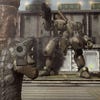Front Mission Evolved
Crying and Wanzing.
In part, the problem's with the title. The Front Mission name has always been synonymous with the Japanese tactical RPG: a futuristic robot version of chess, all giant bipedal tanks blowing the limbs from one another with ponderous missile attacks planned in between sips of tea and head-scratching.
In 1997, when Squaresoft first tried its hand at a real-time version of the game – giving players direct control of the Wanzers and a cockpit-eye view of the action – it dubbed the release Front Mission: Alternative. The title made clear that the game was an experimental spin-off, an alternative for those who find thrills more readily in split-second evasive sidesteps from a hail of rocket fire than the statistical dice rolls with which the series made its name.
Front Mission Evolved, though? That implies to the series faithful that the old way of playing is obsolete and that every TRPG, if it dreams hard enough and makes friends with enough Western developers, can one day be an Armored Core clone. Before the game's even begun, it has alienated long-standing Front Mission fans, suggesting that their series has switched genre with no plans to look back.
Square Enix, however, isn't too interested in Front Mission's existing fans. Sales for the series have been so lacklustre in the West that the publisher left the fifth entry in Japan. No, Front Mission Evolved is gunning for a brave new audience with this Double Helix-developed title: one to whom a mecha-themed cross between Modern Warfare and Forza Motorsport should, in their estimation, prove irresistible.
At first touch and played with an open mind, it seems as though the decision was a sound one. The Wanzer you pilot is fast and responsive (in stark contrast to the lumbering machines in Front Mission: Alternative). A tap of a button engages thrusters, allowing you to skid at speed across the environment, launching into the air to access raised platforms and change directions with unlikely ease.
You line up shots on targets – which range from opposing Wanzers to helicopters and tanks – in much the same way as in any third-person shooter, while a lock-on reticule allows you to unleash a clutch of missiles even as you streak past your enemy. At close range you can melee enemies with the hefty lump of metal in your left hand and with these three basic weapon types you feel as though you can manage close-, middle- and long-range targets with rare ease.
Part way into the game you gain access to a prototype technology, known as E.D.G.E., which allows you to trigger a heightened state of consciousness when you've eliminated enough targets, throwing the game into slow motion and increasing the effectiveness of your aim and damage.
The button configuration is simple and easy to learn, a far cry from, say, Steel Battalion's sim-like approach, and Double Helix has done a commendable job of easing in gamers put off by mecha games' traditional fussiness. Within minutes you'll be skidding around the game's environments, launching missile attacks while pock-marking buildings with a pitter-patter of machine gun fire and in these simple but bombastic actions, the game is often exhilarating.
The environments, which over the course of the five-act storyline range from New York to the ice plains of Antarctica, are pretty and robust, but lack detail. Some objects are destructible, while others stand resolute no matter how much gunfire they endure: a disappointing inconsistency. But the real problem is the game's lack of variety. In the straight Wanzer-piloting stages you must, almost without exception, move from A to B to boss fight, taking down weaker enemies en route.





